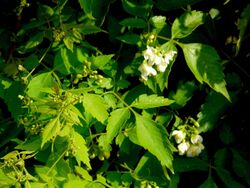Biology:Cardiospermum grandiflorum
| Showy balloonvine | |
|---|---|

| |
| Scientific classification | |
| Kingdom: | Plantae |
| Clade: | Tracheophytes |
| Clade: | Angiosperms |
| Clade: | Eudicots |
| Clade: | Rosids |
| Order: | Sapindales |
| Family: | Sapindaceae |
| Genus: | Cardiospermum |
| Species: | C. grandiflorum
|
| Binomial name | |
| Cardiospermum grandiflorum | |
| Synonyms | |
| |
Cardiospermum grandiflorum, commonly known as showy balloonvine, heart pea or heart seed,[3] is a species of climbing plant native to eastern Argentina and Brazil.[1]
Taxonomy
It was described by Olof Swartz and is in the family Sapindaceae in his work Nova Genera & Species Plantarum seu Prodromus descriptionum Vegetabilium, maximam partem incognitorum quae sub itinere in Indiam Occidentalem annis 1783–87 (New genera and plant species, or Preliminary description of plants, mostly unknown, which were collected during a trip to East India in 1783–1787), written by him on the results of the expedition to the Caribbean.[1]
Description
The species can grow over 10 m (33 ft) long and it has small white flowers.[4] It is a herbaceous, evergreen, fast-growing liana with a tough stem that clings to the support with antennae. Leaves are compound, consisting of leaves with large teeth.
Inflorescence
The flowers are small, slightly fragrant, with creamy white petals. The fruit is a capsule, cracking into three parts when ripe. Seeds are black, hard, with a membranous wing. In warm climates, it reproduces by self seeding, as well as vegetatively, such as by root pieces.[5]
Similar species
Cardiospermum grandiflorum is a large growing, semi-woody perennial, whereas Cardiospermum halicacabum is smaller in size, less woody and usually an annual. C. grandiflorum has larger fruit than the more compact fruit of C. halicacabum. A kidney-shaped hilum exists on C. halicacabum seeds and a round hilum on C. grandiflorum seeds. Furthermore, the leaves and stems of C. grandiflorum have small reddish hairs that are lacking in C. halicacabum, which additionally has smaller flowers than those of C. grandiflorum.[6]
Invasive species
Planted as an ornamental, it has been introduced to all continents except Antarctica, and is a dangerous invasive in places. The species has been added to the list of invasive alien species of Union Concern since 2019.[7] This means that the plant cannot be imported or sold anywhere in the European Union.[8]
It is also a significant environmental weed in eastern New South Wales and south-eastern Queensland, where it is listed as a priority environmental weed in four Natural Resource Management Regions.[9] also on the New Zealand NPPA list of banned plants.
Gallery
References
- ↑ 1.0 1.1 1.2 "Cardiospermum grandiflorum". BioNET-EAFRINET. http://keys.lucidcentral.org/keys/v3/eafrinet/weeds/key/weeds/Media/Html/Cardiospermum_grandiflorum_(Balloon_Vine).htm. Retrieved 7 October 2014.
- ↑ Kunth Nov. Gen. Sp. (quarto ed.) 5: 99, t. 439 1821
- ↑ "Cardiospermum grandiflorum". Invasives. Archived from the original on 12 October 2014. https://web.archive.org/web/20141012214958/http://www.invasives.org.za/invasive-species/item/213-balloon-vine-cardiospermum-grandiflorum.html. Retrieved 7 October 2014.
- ↑ "Balloon Vine". North Coast Weeds. http://www.northcoastweeds.org.au/balloon-vine/. Retrieved 7 October 2014.
- ↑ "Balloon vine (Cardiospermum grandiflorum)". Eurobodalla Shire Council. http://www.esc.nsw.gov.au/living-in/about/our-natural-environment/introduced-plants-and-animals/weeds/balloon-vine-cardiospermum-grandiflorum. Retrieved 7 October 2014.
- ↑ The ecology, biogeography, history and future of two globally important weeds: Cardiospermum halicacabum Linn. and C. grandiflorum Sw. NeoBiota. 11 October 2013. Retrieved 6 December 2021.
- ↑ "List of Invasive Alien Species of Union concern - Environment - European Commission". https://ec.europa.eu/environment/nature/invasivealien/list/index_en.htm.
- ↑ "European Regulation on IAS". https://eur-lex.europa.eu/legal-content/EN/TXT/?uri=celex%3A32014R1143.
- ↑ Cardiospermum grandiflorum Sweet Environmental Weeds of Australia
Wikidata ☰ Q15547168 entry
 |







